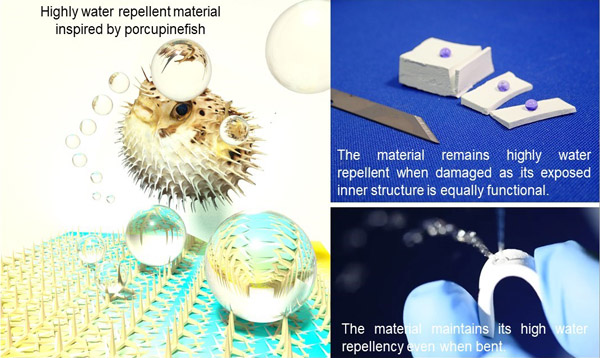Development of a Highly Durable and Water-Repellent Material Inspired by Porcupinefish
—Abrasion-Resistant and Flexible, It May Be Used to Protect Various Structural Materials—
2019.09.10
National Institute for Materials Science (NIMS)
NIMS has developed a novel, highly water-repellent material inspired by porcupinefish skin. This material is superior to conventional water-repellent materials due to its significantly enhanced abrasion resistance and flexibility. It may therefore be useful in extending the durability of various structural materials.
Abstract
- NIMS has developed a novel, highly water-repellent material inspired by porcupinefish skin. This material is superior to conventional water-repellent materials due to its significantly enhanced abrasion resistance and flexibility. It may therefore be useful in extending the durability of various structural materials.
- Water repellency has been a major research focus as a means of keeping the surfaces of materials dry, thereby eliminating the effects of moisture, including the growth of frost, corrosion and mold and the buildup of grime. Highly water-repellent materials need to have uneven surfaces at the micro- to nano-scale. However, these structures make materials brittle when subjected to external forces, such as abrasion, twisting and scratching, immediately impairing their water repellency.
- Inspired by porcupinefish skin, the NIMS research team recently developed a water-repellent material with enhanced durability. This skin is composed of two types of materials with contrasting mechanical properties: hard, tetrapod-shaped spines and highly flexible skins. Using this composite structure as a model, the team succeeded in developing a highly water-repellent material by densely integrating tetrapod-shaped inorganic nanomaterials into a flexible silicone resin. This material is capable of continuously maintaining its microscopic uneven surface structure even when deformed or damaged by external forces.
- This highly durable and water-repellent material can be easily produced by simply combining and kneading together the inorganic nanomaterial and a general-purpose resin. The material is therefore compatible with conventional resin casting and painting techniques. In future development efforts, we intend to put this material into practical use in various fields in which the use of water-repellent materials has been limited by inadequate durability (e.g., paints applied to the hulls of ships to reduce water resistance).
- This project was carried out by a research team led by Yoshihiro Yamauchi (International Center for Young Scientists, NIMS) and Masanobu Naito (Leader of the Data-driven Polymer Design Group, Research and Services Division of Materials Data and Integrated System, NIMS).
This research was supported by the National Security Technology Research Promotion Fund. - This research was published in the online version of ACS Applied Materials & Interfaces on August 20, 2019.

figure: Porcupinefish-inspired superhydrophobic materials with high durability.
Related files
- Research and Services Division of Materials Data and Integrated System (MaDIS)
Contacts
(Regarding this research)
-
Masanobu Naito
Group Leader,
Data-driven Polymer Design Group,
Research and Services Division of Materials Data and Integrated System (MaDIS),
National Institute for Materials Science (NIMS)
Tel: +81-29-860-4783
E-Mail: NAITO.Masanobu=nims.go.jp
(Please change "=" to "@")
(For general inquiries)
-
Public Relations Office
National Institute for Materials Sciences
Tel: +81-29-859-2026
Fax: +81-29-859-2017
E-Mail: pressrelease=ml.nims.go.jp
(Please change "=" to "@")
Recent Press Release
-
Simultaneous Imaging of Intracellular DNA and RNA Using Harmless Light
2025.10.27
-
Development of an AI Device Using Ion Gel and Graphene That Dramatically Streamlines Machine Learning Computations
2025.10.14
-
Demonstrating a Novel Method to Modulate Heat Flow Through the Collective Motion of Spins
2025.10.06
